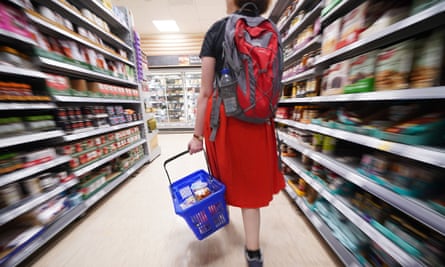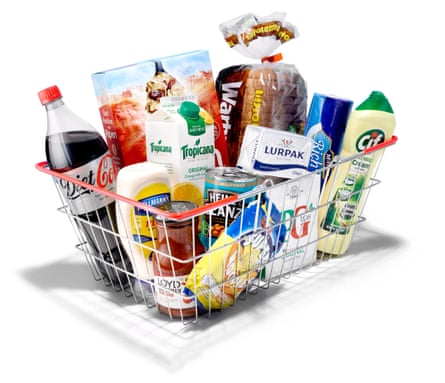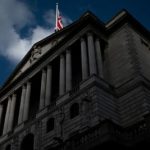
David Cameron was famously asked the price of bread a decade ago and struggled to answer, saying instead he used an electric breadmaker. The answer was around 47p.
Then, the Tories were struggling to deal with a cost of living crisis and were accused of being out of touch. Now, here we are again a decade later, with the prime minister Rishi Sunak and his chancellor Jeremy Hunt being accused of having no clue. Only now an average white loaf is £1.37 – and this time it’s not just politicians that are under pressure to do something about it.
People are also questioning how companies, across many sectors of the economy, are still looking pretty rosy while they suffer.
In aviation, Ryanair expects to report record profits this year following a jump in the price of flights this summer by up to 20%.
Since 2020, food prices have soared more than 20%, and the supermarket chains Tesco and Sainsbury have enjoyed their best profit margins in a decade.
Multinational companies such as PepsiCo, Proctor & Gamble and Nestlé – the world’s largest food and beverages company – have cruised through the last two years promising shareholders bumper dividends while profits remain intact. And consumers of services from insurance to mobile phones, mortgages to energy have seen bills soar even as providers clock up huge profits.
Increasingly, the question is being asked: why it is that so many businesses have appeared to maintain or improve their results during a cost of living crisis in which households have suffered one of the worst periods of falling real incomes in a century? Are we living in rip-off Britain?
With the UK’s inflation stuck at 8.7% in May and food inflation above 18%, even as prices tumble across most of Europe and the US, is it any wonder Which? surveys show that consumer trust in UK supermarkets has fallen to a nine-year low.
The clamour to find out whether Britons are being ripped off forced Hunt to call in the Competition and Markets Authority (CMA), and the energy, water and communications watchdogs last week. Hunt pressed them on whether there is a profiteering problem in their sectors, and on what they are doing about it.
 View image in fullscreenThe Competition and Markets Authority has proposed a taskforce to monitor grocery pricing. Photograph: Yui Mok/PA
View image in fullscreenThe Competition and Markets Authority has proposed a taskforce to monitor grocery pricing. Photograph: Yui Mok/PA
Hunt gave the regulators a mission to measure the effect of higher profits, but within a day of the meeting, a trade magazine revealed that the CMA had already received evidence of “profiteering” in retail similar to that seen among energy companies, which were found to be making excessive profits and eventually faced a windfall tax.
The Grocer said the authority had a dossier of evidence from various retail sectors, before a report due to be published this week.
Supermarket bosses have rejected claims they were inflating profit margins on the back of the cost-of-living crisis in evidence to a cross-party committee of MPs. However, it is understood the evidence to the CMA is compelling enough for it to propose setting up a taskforce to monitor grocery pricing.
Meanwhile, economists in growing numbers have calculated that profits make up the biggest slice of rising prices this century and can be blamed for pushing inflation to its highest level in 30 years.
European Central Bank president Christine Lagarde and the International Monetary Fund (IMF) said last week that a large proportion of inflation last year across the eurozone could be attributed to profiteering companies.
Lagarde asked companies to refrain from repeating the trick this year, telling them she would be forced to keep interest rates high for a longer period if they did.
Official figures of corporate profitability produced by the Office for National Statistics show that the net margin of sales income over costs has remained steady at 10% over the two years to December 2022, arresting a decline from 12% in 2014.
Bank of England officials have taken this to mean that little has changed in the way corporations price their goods and services. The only pressure has come from rising costs and higher wage bills.
But in a report last week, Simon MacAdam, a senior economist at the consultancy Capital Economics, calculated that firms across the industrialised world had, by virtue of broadly maintaining profit margins, “pushed inflation two to three percentage points higher than would otherwise have been the case”.
“More recently,” he says, “the UK stands out among advanced economies as having seen formidably resilient corporate margins in the face of surging costs. In the second half of 2022, UK inflation was about four percentage points higher than it would have been had profits absorbed rising costs as they did before the pandemic.”
 View image in fullscreenIneos Grangemouth Crude oil refinery in Scotland. Chancellor Jeremy Hunt has pressed energy sector over profiteering claims. Photograph: Murdo MacLeod/The Guardian
View image in fullscreenIneos Grangemouth Crude oil refinery in Scotland. Chancellor Jeremy Hunt has pressed energy sector over profiteering claims. Photograph: Murdo MacLeod/The Guardian
It means inflation in the second half of last year that averaged 10% would have been only 6% in the UK – which might have persuaded the Bank of England to ease back on several interest rate rises.
A report last year by the Unite union, updated in March, showed how the top 350 companies listed on the London Stock Exchange enjoyed a rise in average profit margins – a company’s revenue above the cost of sales – from 5.7% in the first half of 2019 to 10.7% in the first half of 2022.
Paul Donovan, chief economist at UBS Wealth Management, was one of the earliest to monitor price-gouging by firms in particular sectors. He says three waves of inflation can be identified. The first was a transitory rise in the price of consumer durable goods such as children’s toys and TV sets as households spent government subsidies handed out during the pandemic.
UK watchdogs agree on ‘action plan’ to prevent consumers being ripped offRead more
The second wave followed the huge spike in gas and electricity prices in the winter of 2022 that worsened once the Russian invasion of Ukraine began. But, he says, “recent inflation has been driven by an unusual expansion of profit margins. Profit margin-led inflation occurs when companies tell their customers a convincing story that lets them raise prices without significantly reducing demand. It is inflation driven by spin, not substance.”
MacAdam’s study is the first to judge the effect on UK inflation. Neither the Bank of England nor the Treasury has made a similar calculation. He says firms have only used the market power available to them and disputes they can be accused of greedflation, a term used by unions to reflect how shareholders have been protected over the past three years while workers have suffered a drop in disposable incomes.
That doesn’t wash with Unite general secretary Sharon Graham, who says the union’s research and latest analysis by the IMF and ECB reveals “the economy is being rigged against workers”.
Energy
Profiteering is the name of the game in the energy industry. In their book The World for Sale, authors Javier Blas and Jack Farchy show how the big four commodity traders have been transformed by the recent crisis. Vitol, Cargill, Glencore and Trafigura made about £10bn between them for the decade from 2010. In 2022 their net income was more than $46bn.
Common Wealth, the left of centre thinktank, has shown how the electricity industry is stuffed with price-gouging firms, none more so than the electricity distribution companies. There are 14 that connect National Grid to homes and offices. They boasted profit margins of 43% in the last year. The gas distribution companies enjoy profit margins of 36.6%.
Shipping oil and liquid gas around the world has also been a very profitable business. According to the shipping consultancy Drewry, in the three years from 2020 to 2022, the industry generated as much profit as it had during the previous six decades combined.
Haggle, slash and switch: five ways to cut household bills as UK prices soarRead more
Mortgage/savings
Mortgage costs have increased by more than £3,000 a year for a household with an average mortgage of about £130,000.
The Resolution Foundation thinktank says signs that inflation is proving stickier than expected “have raised market expectations for how high the Bank of England will raise interest rates, with total annual mortgage repayments now on course to rise by £15.8bn by 2026, and by £2,900 for the average household re-mortgaging next year
Banks claim they are not profiteering because intense competition means the margin between how much they pay the Bank of England to borrow money and the interest rate offered to customers is wafer thin. The same argument is used to justify meagre savings rates, despite MoneySavingExpert boss and broadcaster Martin Lewis saying that savers are being ripped off.
The value of all the main UK banks appears to support their argument. Investors have balked at buying bank shares, and share prices are much the same now as a couple of years ago, when interest rates were almost zero.
Car insurance
Premiums have jumped 43.1% according to the latest figures for May produced by the Office for National Statistics (ONS), leaving many car-owners fuming. The industry says the figure is nearer 16% once the calculation strips out renewal offers by insurers, which are often exaggerated, and focuses solely on the prices paid.
Insurers say they face a growing tide of claims while repairs are much more costly following a steep rise in car prices, and especially secondhand cars, forcing them to make larger payouts. Higher energy charges, paint prices and courtesy-car costs are also factors pushing up the price of repairs.
Which? says customers are encouraging higher renewal prices by not shopping around. GlobalData’s 2022 UK Insurance Consumer Survey found that only 28.8% of car insurance customers had switched insurer at renewal (down from 30.7% in 2021).
Telecoms
Britain’s biggest mobile and broadband companies added to the financial pain this spring with the biggest round of price rises for more than 30 years.
Most providers link annual increases to inflation, regardless of whether a customer is part-way through a contract. During the pandemic, when inflation was near zero, they added 3.9 percentage points on top, arguing the measure was vital to keep investing in services as broadband and mobile demand boomed.
However, analysis by the Guardian found that six companies controlling most of the telecoms market kept the 3.9 percentage point surcharge in place this spring – when inflation was surging – meaning consumers faced bill increases of up to 17.3%.
The charges have generated billions of pounds in extra revenue for providers, according to estimates by the price comparison website Uswitch, while hitting the average customer with an annual bill increase of £222 for broadband and £114 for mobile.
Chancellor Jeremy Hunt raised the issue in Downing Street talks with regulators last week. However, the government is under pressure to take further action. Labour has called for the practice to be banned.
 View image in fullscreenOn the rise … Photograph: Frankie Angel/Alamy
View image in fullscreenOn the rise … Photograph: Frankie Angel/Alamy
Food
Research from Which? suggests soaring grocery prices are worsening the mental health of one in four people across Britain. According to a survey, the rising price of food was also having a negative effect on sleep, diet and overall physical health.
The British Retail Consortium said last week that its measure of shop prices showed that fresh-food inflation slowed to 15.7% in June, down from 17.2% in May.
The producers of fresh food have complained that rocketing prices of fertiliser and feedstuffs for animals in the early part of the pandemic were replaced by high energy prices and high wages paid to a declining number of workers prepared to stay in agriculture.
Milk was among many items to soar in price. UBS Wealth Management chief economist Paul Donovan said the usual practice adopted by supermarkets and convenience stores of absorbing increases in milk-production costs was set aside earlier this year.
A 33% increase in farm gate prices in February on a year earlier translated into a 43% increase in the retail price of milk, a trend that was maintained until last month when supermarkets started to cut dairy food prices, though convenience stores have in the main kept the price of these products at the previously higher levels.

